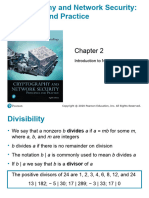0% found this document useful (0 votes)
24 views2 pagesIntro To Number Theory
Number theory is a branch of pure mathematics focused on the study of integers and their properties. Key concepts include divisibility, prime numbers, the greatest common divisor, least common multiple, and modular arithmetic, all of which have practical applications in fields like cryptography and computer science. The Fundamental Theorem of Arithmetic states that every integer greater than 1 can be uniquely expressed as a product of prime numbers.
Uploaded by
pelagiemuka73Copyright
© © All Rights Reserved
We take content rights seriously. If you suspect this is your content, claim it here.
Available Formats
Download as PDF, TXT or read online on Scribd
0% found this document useful (0 votes)
24 views2 pagesIntro To Number Theory
Number theory is a branch of pure mathematics focused on the study of integers and their properties. Key concepts include divisibility, prime numbers, the greatest common divisor, least common multiple, and modular arithmetic, all of which have practical applications in fields like cryptography and computer science. The Fundamental Theorem of Arithmetic states that every integer greater than 1 can be uniquely expressed as a product of prime numbers.
Uploaded by
pelagiemuka73Copyright
© © All Rights Reserved
We take content rights seriously. If you suspect this is your content, claim it here.
Available Formats
Download as PDF, TXT or read online on Scribd
/ 2




















































